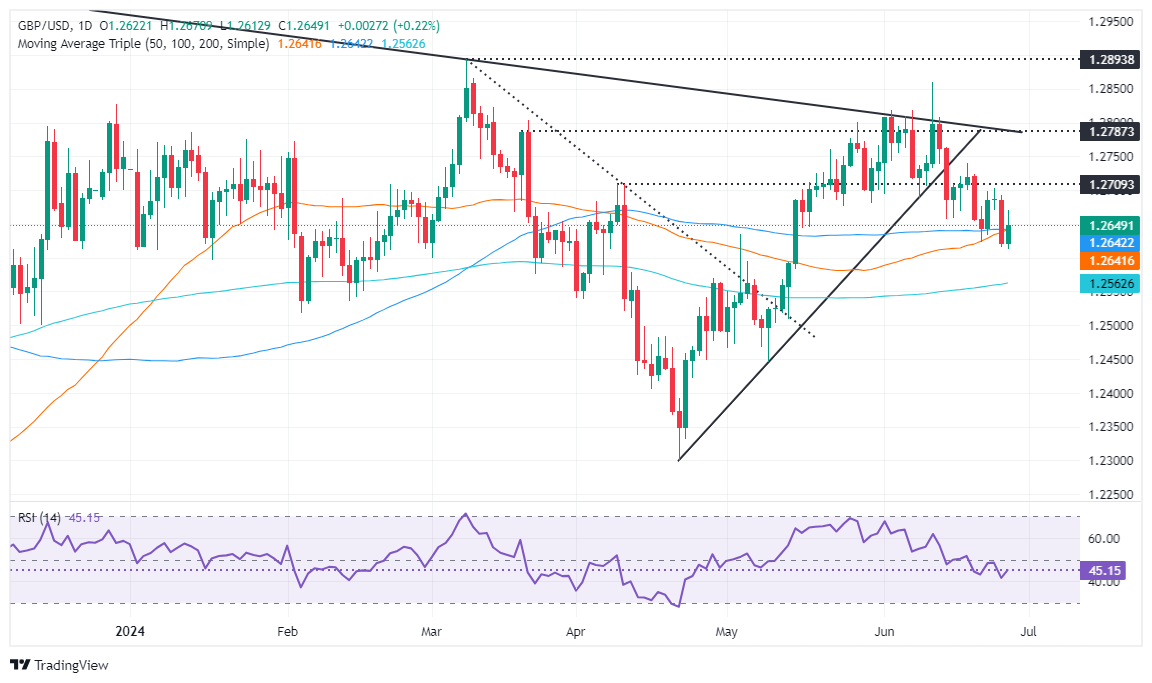GBP/USD Price Analysis: Remain bearish despite bouncing off weekly lows

- GBP/USD climbs to 1.2652, up 0.25%, remaining under the 1.2703 weekly high.
- Technical stance neutral; daily MAs range between 1.2641 and 1.2557.
- ‘Evening star’ pattern and bearish RSI suggest potential drop; support at 1.2641/39 (100 & 50-DMAs), 1.2600, 1.2555 (200-DMA).
- For bullish move, GBP/USD must surpass 1.2700 and tackle resistance at 1.2730/40.
The Pound Sterling gathers some steam versus the Greenback, yet it remains trading below the weekly highs of 1.2703 as investors await the US Personal Consumption Expenditure (PCE) Price Index release, along with fears of the upcoming general election in the UK. The GBP/USD trades at 1.2652, up 0.25%.
GBP/USD Price Analysis: Technical outlook
The GBP/USD is neutral biased further confirmed by almost fla daily moving averages (DMAs) trapped within the 1.2641-1.2557 range. The formation of an ‘evening star’ kept traders from reclaiming 1.2700, exacerbated Cable’s fall to a six-week low of 1.2612.
Momentum favors sellers as depicted by the Relative Strength Index (RSI) standing at bearish territory; therefore, the GBP/USD path of least resistance is tilted to the downside.
First support would be the confluence of the 100 and 50-DMAs at around 1.2641/39, followed by the 1.2600 psychological figure. Once surpassed, the next demand zone to challenge would be the 200-DMA at 1.2555.
For a bullish continuation, traders must claim 1.2700 and clear a previous support trendline turned resistance at around 1.2730/40.
GBP/USD Price Action – Daily Chart
Pound Sterling FAQs
The Pound Sterling (GBP) is the oldest currency in the world (886 AD) and the official currency of the United Kingdom. It is the fourth most traded unit for foreign exchange (FX) in the world, accounting for 12% of all transactions, averaging $630 billion a day, according to 2022 data. Its key trading pairs are GBP/USD, aka ‘Cable’, which accounts for 11% of FX, GBP/JPY, or the ‘Dragon’ as it is known by traders (3%), and EUR/GBP (2%). The Pound Sterling is issued by the Bank of England (BoE).
The single most important factor influencing the value of the Pound Sterling is monetary policy decided by the Bank of England. The BoE bases its decisions on whether it has achieved its primary goal of “price stability” – a steady inflation rate of around 2%. Its primary tool for achieving this is the adjustment of interest rates. When inflation is too high, the BoE will try to rein it in by raising interest rates, making it more expensive for people and businesses to access credit. This is generally positive for GBP, as higher interest rates make the UK a more attractive place for global investors to park their money. When inflation falls too low it is a sign economic growth is slowing. In this scenario, the BoE will consider lowering interest rates to cheapen credit so businesses will borrow more to invest in growth-generating projects.
Data releases gauge the health of the economy and can impact the value of the Pound Sterling. Indicators such as GDP, Manufacturing and Services PMIs, and employment can all influence the direction of the GBP. A strong economy is good for Sterling. Not only does it attract more foreign investment but it may encourage the BoE to put up interest rates, which will directly strengthen GBP. Otherwise, if economic data is weak, the Pound Sterling is likely to fall.
Another significant data release for the Pound Sterling is the Trade Balance. This indicator measures the difference between what a country earns from its exports and what it spends on imports over a given period. If a country produces highly sought-after exports, its currency will benefit purely from the extra demand created from foreign buyers seeking to purchase these goods. Therefore, a positive net Trade Balance strengthens a currency and vice versa for a negative balance.
Information on these pages contains forward-looking statements that involve risks and uncertainties. Markets and instruments profiled on this page are for informational purposes only and should not in any way come across as a recommendation to buy or sell in these assets. You should do your own thorough research before making any investment decisions. FXStreet does not in any way guarantee that this information is free from mistakes, errors, or material misstatements. It also does not guarantee that this information is of a timely nature. Investing in Open Markets involves a great deal of risk, including the loss of all or a portion of your investment, as well as emotional distress. All risks, losses and costs associated with investing, including total loss of principal, are your responsibility. The views and opinions expressed in this article are those of the authors and do not necessarily reflect the official policy or position of FXStreet nor its advertisers. The author will not be held responsible for information that is found at the end of links posted on this page.
If not otherwise explicitly mentioned in the body of the article, at the time of writing, the author has no position in any stock mentioned in this article and no business relationship with any company mentioned. The author has not received compensation for writing this article, other than from FXStreet.
FXStreet and the author do not provide personalized recommendations. The author makes no representations as to the accuracy, completeness, or suitability of this information. FXStreet and the author will not be liable for any errors, omissions or any losses, injuries or damages arising from this information and its display or use. Errors and omissions excepted.
The author and FXStreet are not registered investment advisors and nothing in this article is intended to be investment advice.




